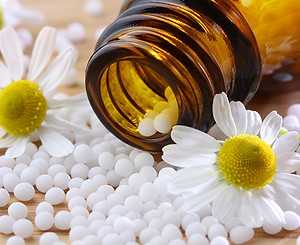
HOMEOPATHIC MEDICINE

The Origin of Homeopathy
Homeopathy is a system of alternative medicine that was developed in 1796 by Samuel Hahnemann. It is based on his doctrine of 'like cures like', which means that a substance that causes symptoms of disease in healthy people would cure similar symptoms in sick people. He believed that the underlying causes of disease were phenomena that he termed 'miasms' and that homeopathic preparations addressed these. In his research, he tested what effects certain substances produced in humans. This procedure would later become termed as 'homeopathic proving'. He published his provings in 1805, and again in 1810, with a second collection of 65 preparations listed in his book, 'Materia Medica Pura'.
How Does It Work?
There are hundreds of different homeopathic remedies, which can be prescribed in a variety of different dilutions for thousands of symptoms. Various substances from the plant, mineral or animal kingdom are used in homeopathy. Homeopathic treatments are highly individualized. There is no uniform prescribing standard for homeopathic practitioners. Almost any type of material can become a homeopathic medicine. Once a homeopathic 'proving' is conducted, it is then known how that medicine can be useful when administered in homeopathic doses.
How Are The Pills Made?
Homeopathic pills are made from an inert substance (often sugars), upon which a drop of liquid homeopathic preparation is placed and allowed to evaporate. Homeopathic medicine itself is made from extremely small quantities (nano particles) of substances extracted from plants, animals or minerals. The remedies are so diluted that it is difficult to find any molecules of the original substance in the remedy. The process of dilution and succussion is termed 'dynamization' or 'potentization' by homeopaths. Ultimately, through Hahnemann's original research and provings, a standard of advocated 30C dilutions is used for most purposes today. Some homeopathic preparations involve poisons such as Belladonna, arsenic, and poison ivy, which are highly diluted in the homeopathic preparation and are therefore, best prescribed by homeopaths, physicians or natural health practitioners.
How Is It Prescribed?
Homeopaths or homeopathic practitioners generally begin with detailed examinations of their patients' histories, including: questions regarding their physical, mental and emotional states, their life circumstances and any physical or emotional illnesses. The homeopath then attempts to translate this information into a complex formula of mental and physical symptoms, including likes, dislikes, innate predispositions and even body type. Dosage requirements are reduced as symptoms of illness dissipate.
*As part of one's consultation, Dr. Rodger, ND may prescribe certain homeopathic medicines for individuals based on muscle testing and symptom assessments.
Commonly Used Homeopathic Medicines
Because there are literally hundreds of Homeopathic Medicines, laws regulating the practice of homeopathy in the United States vary from state to state. Usually, individuals who are licensed to practice medicine or another health care profession can legally practice homeopathy. Here are some of the most commonly recognized homeopathic medicines.
Arnica (mountain daisy): For shock and trauma from injury. It helps to reduce pain from injury and to speed the healing process. It is taken in pellet form. Another way to use it is in a topical external application in a gels, ointment, or spray form. Arnica is great for healing sprains and black and blue bruising (without broken skin).
Chamomilla (chamomille): Chamomilla is a good remedy for irritable infants. It has soothing effects and helps to calm the body.
Hypericum (St. John’s wort): This remedy is for injuries to the nerves, including the fingers, toes, and the back. Injuries with shooting pains should be given this remedy. St. John's Wort is also known for its antidepressant and anti-inflammatory properties.
Magnesia phosphorica (phosphate of magnesia): This remedy is for cramps, including menstrual cramps. It is used for radiating pain symptoms, and it is also an ideal remedy for headaches with darting pains.
Nux vomica (poison nut): This is a common remedy for treating symptoms of overeating or from drinking too much alcohol. It can help to remedy digestive problems such as constipation, bloating, heartburn, and nausea.
Rhus tox (poison ivy): This medicine is the most common remedy for sprains and strains besides Arnica. It is also often given to people with the flu or arthritis who experience pain on initial motion which is reduced the more the person continues to move.
Your Health is an Investment - Not an Expense

